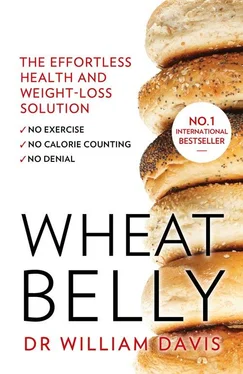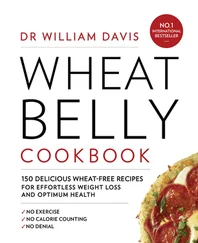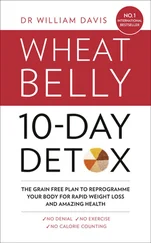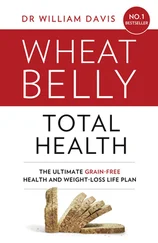In fact, the degree of processing, from a blood sugar standpoint, makes little difference: wheat is wheat, with various forms of processing or lack of processing, simple or complex, high-fibre or low-fibre, all generating similarly high blood sugars. Just as ‘boys will be boys’, amylopectin A will be amylopectin A. In healthy, slender volunteers, two medium-sized slices of whole-wheat bread increase blood sugar by 30 mg/dl (from 93 to 123 mg/dl), no different from white bread. 6In people with diabetes, both white and whole-grain bread increase blood sugar 70 to 120 mg/dl over starting levels. 7
One consistent observation, also made in the original University of Toronto study as well as in subsequent efforts, is that pasta has a lower two-hour GI, with whole-wheat spaghetti showing a GI of 42 compared to white-flour spaghetti’s GI of 50. Pasta stands apart from other wheat products, probably due, in part, to the compression of the wheat flour that occurs during the extruding process, slowing digestion by amylase. (Rolled fresh pasta, such as fettuccine, has similar glycaemic properties to extruded pastas.) Pastas are also usually made from Triticum durum rather than aestivum, putting them genetically closer to emmer. But even the favourable GI rating of pasta is misleading, since it is only a two-hour observation and pasta has the curious ability to generate high blood sugars for periods of four to six hours after consumption, sending blood sugars up by 100 mg/dl for sustained periods in people with diabetes. 8 , 9
These irksome facts have not been lost on agricultural and food scientists, who have been trying, via genetic manipulation, to increase the content of so-called resistant starch (starch that does not get fully digested) and reduce the amount of amylopectin. Amylose is the most common resistant starch, comprising as much as 40 to 70 per cent by weight in some purposefully hybridised varieties of wheat. 10
Therefore, wheat products elevate blood sugar levels more than virtually any other carbohydrate, from beans to chocolate bars. This has important implications for body weight, since glucose is unavoidably accompanied by insulin, the hormone that allows entry of glucose into the cells of the body, converting the glucose to fat. The higher the blood glucose after consumption of food, the greater the insulin level, the more fat is deposited. This is why, say, eating a three-egg omelette that triggers no increase in glucose does not add to body fat, while two slices of whole-wheat bread increases blood glucose to high levels, triggering insulin and growth of fat, particularly abdominal or deep visceral fat.
There’s even more to wheat’s curious glucose behaviour. The amylopectin A-induced surge in glucose and insulin following wheat consumption is a 120-minute-long phenomenon that produces the ‘high’ at the glucose peak, followed by the ‘low’ of the inevitable glucose drop. The surge and drop creates a two-hour roller coaster ride of satiety and hunger that repeats itself throughout the day. The glucose ‘low’ is responsible for stomach growling at 9 am, just two hours after a bowl of wheat cereal or an English muffin breakfast, followed by 11 am pre-lunch cravings, as well as the mental fog, fatigue and shakiness of the hypoglycaemic glucose nadir.
Trigger high blood sugars repeatedly and/or over sustained periods, and more fat accumulation results. The consequences of glucose-insulin-fat deposition are especially visible in the abdomen – resulting in, yes, wheat belly. The bigger your wheat belly, the poorer your response to insulin, since the deep visceral fat of the wheat belly is associated with poor responsiveness, or ‘resistance’, to insulin, demanding higher and higher insulin levels, a situation that cultivates diabetes. Moreover, the bigger the wheat belly in males, the more oestrogen is produced by fat tissue, and the larger the breasts. The bigger your wheat belly, the more inflammatory responses that are triggered: heart disease and cancer.
Because of wheat’s morphine-like effect (discussed in the next chapter) and the glucose-insulin cycle that wheat amylopectin A generates, wheat is, in effect, an appetite stimulant . Accordingly, people who eliminate wheat from their diet consume fewer calories, something I will discuss later in the book.
If glucose-insulin-fat provocation from wheat consumption is a major phenomenon underlying weight gain, then elimination of wheat from the diet should reverse the phenomenon. And that is exactly what happens.
For years, wheat-related weight loss has been observed in patients with coeliac disease, who must eliminate all foods containing gluten from their diets to halt an immune response gone awry, which in coeliac patients essentially destroys the small intestine. As it happens, wheat-free, gluten-free diets are also amylopectin A-free.
However, the weight-loss effects of wheat elimination are not immediately clear from clinical studies. Many coeliac sufferers are diagnosed after years of suffering and begin the diet change in a severely malnourished state due to prolonged diarrhoea and impaired nutrient absorption. Underweight, malnourished coeliac sufferers may actually gain weight with wheat removal thanks to improved digestive function.
But if we look only at overweight people who are not severely malnourished at the time of diagnosis who remove wheat from their diet, it becomes clear that this enables them to lose a substantial amount of weight. A Mayo Clinic/University of Iowa study of 215 obese coeliac patients showed 27.5 pounds of weight loss in the first six months of a wheat-free diet. 11In another study, wheat elimination slashed the number of people classified as obese (body mass index, or BMI, 30 or greater) in half within a year. 12Oddly, investigators performing these studies usually attribute the weight loss of wheat- and gluten-free diets to lack of food variety. (Food variety, incidentally, can still be quite wide and wonderful after wheat is eliminated, as I will discuss.)
Advice to consume more healthy whole grains therefore causes increased consumption of the amylopectin A form of wheat carbohydrate, a form of carbohydrate that, for all practical purposes, is little different, and in some ways worse, than dipping your spoon into the sugar bowl.
GLUTEN: WE HARDLY KNOW YA!
If you were to add water to wheat flour, knead the mixture into dough, then rinse the glob under running water to wash away starches and fibre, you’d be left with a protein mixture called gluten.
Wheat is the principal source of gluten in the diet, both because wheat products have come to dominate and because most Americans do not make a habit of consuming plentiful quantities of barley, rye, bulgur, kamut or triticale, the other sources of gluten. For all practical purposes, therefore, when I discuss gluten, I am primarily referring to wheat.
While wheat is, by weight, mostly carbohydrate as amylopectin A, gluten protein is what makes wheat ‘wheat’. Gluten is the unique component of wheat that makes dough ‘doughy’: stretchable, rollable, spreadable, twistable, baking gymnastics that cannot be achieved with rice flour, corn flour or any other grain. Gluten allows the pizza-maker to roll and toss dough and mould it into the characteristic flattened shape; it allows the dough to stretch and rise when yeast fermentation causes it to fill with air pockets. The distinctive doughy quality of the simple mix of wheat flour and water, properties food scientists call viscoelasticity and cohesiveness, are due to gluten. While wheat is mostly carbohydrate and only 10 to 15 per cent protein, 80 per cent of that protein is gluten. Wheat without gluten would lose the unique qualities that transform dough into bagels, pizza or focaccia.
Here’s a quick lesson in this thing called gluten (a lesson that you might categorise under ‘Know thine enemy’). Glutens are the storage proteins of the wheat plant, a means of storing carbon and nitrogen for germination of the seed to form new wheat plants. Leavening, the ‘rising’ process created by the marriage of wheat with yeast, does not occur without gluten, and is therefore unique to wheat flour.
Читать дальше












